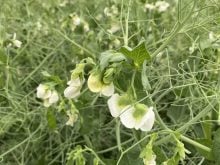DRAYTON VALLEY, Alta. – It’s that time of year again.
Dandelion season.
The familiar bright yellow wildflowers pop up in meadows, yards and gardens and frustrate those who prefer a plain green lawn.
We can thank the early European colonists for bringing the dandelion to America. Its name comes from the French words dent de lion, meaning lion’s tooth.
There are various ways to deal with dandelions depending on whether you hate them or love them.
If you belong to the former category you can dig them out, which is time consuming. Digging down quite deep to get the roots is very important since slicing close to the surface only encourages the plants to grow.
Read Also

Soybean market still figuring out implications of China-U.S. pact
Soybean futures had a muted reaction to the U.S. trade deal with China as the market tries to figure out the nuances of the deal.
Or you can spray them.
“The most common herbicide that’s used on lawns for dandelions is Killex,” said Ron Hockridge, crop specialist with Alberta Agriculture in Wetaskiwin, Alta.
Killex, like any herbicide, is most effective if applied when plants are small. As well, he said, “it won’t harm pets, the environment or the user.”
Common field sprays to control dandelions are Banvel, 2,4-D, MCPA and Ally.
On the other hand, you might consider yourself a lover and prefer not to battle the dandelion. Here are some ways to make the most of the sea of yellow.
Take advantage of the fact that every part of the plant is useful. Karen Drebert, certified herbologist at Supp-Herb Health Foods in Drayton Valley, Alta., said many people aren’t aware of the vitamins and minerals in the plant, including vitamins A and C, potassium, calcium, iron and phosphorus.
The list of alleged medicinal benefits include purifying the blood, improving digestion, improving the quality of breast milk, lowering cholesterol, relieving constipation, lowering blood pressure, improving circulation, softening chapped skin, healing skin sores and even dissolving warts.
Drebert said people should make sure the plants haven’t been sprayed before using them for any medicinal or eating purposes.
Two more ways to enjoy the bright, sunshiny flowers might bring back memories of youth. Split and then tie the stems together to make dandelion jewelry or blow on the fuzzy seedhead to watch the downy parachutes float on a breeze.
Dandelion flowers can be used in wines, teas, soups, salads and facial care applications. The leaves are commonly added to salads and teas, while the roots can be cooked as a vegetable or dried and ground for a coffee substitute. Even sap from the stems is believed to soothe bee stings, cold sores and blisters.
Various cookbooks offer recipes using dandelions and most wine recipe books provide instructions for dandelion wine.
The New York Times Cookbook, published by Harper & Row, carries a variation of a dandelion salad.
Wilted dandelion greens
1 quart coarsely 1 L
shredded dandelion greens
4 strips bacon, 4
diced
2 teaspoons sugar 10 mL
dash black pepper
1Ú2 teaspoon salt 2 mL
1Ú4 teaspoon dry 1 mL
mustard
3 tablespoons 15 mL
mild vinegar
Tough roots or stems should be removed from the greens before shredding. Place the greens in a large bowl. Cook the bacon until crisp. Add the remaining ingredients to the bacon and fat and heat, stirring, until sugar dissolves.
Pour the mixture over the dandelion greens and toss well. It makes three to four servings.
The Harrowsmith Cookbook – Volume 2, published by Camden House, features an unusual recipe.
Dandelions in batter
dandelion heads
1Ú2 cup flour 125 mL
3Ú4 teaspoon salt 3 mL
1Ú4 teaspoon pepper 1 mL
1Ú2 teaspoon baking 2 mL
powder
1 egg, well beaten 1
1Ú2 cup milk 125 mL
oil
Gather a few cups of blooms early in the morning, rinse in cold water, then soak in salt water for about two hours.
Prepare egg batter by sifting together flour, salt, pepper and baking powder. Blend in egg and milk and mix well.
Dip blossoms into batter, then drop, a few at a time, into deep oil heated to 375 F (190 C). Fry until golden brown, turning once.
The Harrowsmith Cookbook – Volume 3, published by Camden House, offers this soup recipe.
Spinach/dandelion soup
If dandelion greens are not available this soup can be made with all spinach or with spinach and escarole. The nutmeg adds a different taste.
6 cups chicken 1.5 L
stock
3 cups chopped 750 mL
dandelion greens
3 cups chopped 750 mL
spinach
3 green onions, 3
chopped
1 clove garlic, crushed 1
salt and pepper
nutmeg
2 hard cooked 2














